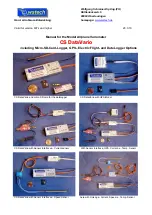
4.2.1
Altimeter Mode
Altitudes are announced in steps of 50 m/100 ft in relation to the take-off altitude. The latter is automatically
calibrated to 0 after switch-on. If a 50-m- step is not trespassed there is an automatic altitude announcement
every 60 seconds (default setting). A step must be over- or underflown at least by 20 m/30 ft before it is
announced again. This avoids unnecessary outputs if the sailplane remains above or under a 50 m/100 ft
step for a longer period of time. The 60 second default setting can be changed in
Setup 1
. Negative
altitudes, i.e. below the take-off point at a slope, generate a shorter voice output interval (default setting 20
sec) which can be changed in
Setup 2.
4.2.2
Integral (Vario) Mode
The integral vario mode is an ideal complement for the vario voice output feature. It informs about the climb-
and descent ratio almost without delay by announcing the average value within a preselected time interval
(default: 20 sec,
Setup 3
).
Within this selected time interval the altitude difference to the previous announcement is determined and
announced in meters/feet, for exemple “minus 18” or “plus 12” with the meaning of 18 meters descent and
12 meters ascent.
The voice output can be selected either in absolute altitude difference or in relative altitude difference per
second. The announcement of, for exemple, “minus 0.6” stands for an altitude loss of 12 meters within 20
seconds.
The voice output mode is selected in
Setup 13.
(The default
setting is “altitude difference”)
In the Integral Mode, the voice output of units (“meters”, “seconds”, etc.) has been omitted deliberately in
order to interrupt the vario tone only for a time as short as possible.
This feature is particularly advantageous when trying to optimize the search pattern in a thermal. Further it
allows the measurement of the sink rate, also at different flap settings, provided there is calm weather and
patience on the pilot`s side.
The Integral Mode allows a fast determination of the minimum sink rate and subsequently the fast discovery
of sink areas and beginning thermals. The fixed time basis (fixed time basis??) avoids mental arithmetic and
makes the integral vario mode a most prefered operating mode, particularly in weak conditions.
4.3
Total Energy Compensation (TEK)
The CS DataVario provides a port for the connection of a TEK probe, a feature which is borrowed from full
scale aviation. In general, the probe is being attached to the fin. There are also probe versions which allow
the installation on the rear fuselage (close behind the wings) on V-tail sailplanes. This probe compensates
for so-called “stick thermals” and it leads to the true indication of thermals. For more information on this
subject, please refer to the related chapter on our webpage www.wstech.de.
The use of this TEK-probe is highly recommended for the demanding model pilot as it is otherwise difficult to
separate thermal alitude gain from (conscious or unconscious) stick movements.
4.4
Altitude Accuracy
Weather changes or normal pressure changes during daytime easily amount to differences of 1 to 3 hPa
(mb) within one hour which in turn yield altitude errors of 10 to 20 m (30 to 60 ft).
During the flight, openings in the fuselage may cause minimal pressure changes on the inside which also
can amount to errors of +/- 10 m or 30 ft.
Relative errors due to small forward speed changes, as they are important in the integral vario mode, are
substantially smaller and negligeable. They are in the range of the altimeter resolution.
The above errors can be checked by a manually generated read-out of the altitude during a low pass of
about 1 to 2 m (3 to 6 ft.) and another read-out after the landing. Differences in altitude are then due to
pressure influences from fuselage openings and, when using the TEK probe, the inherent and speed related
negative pressure at the probe.
The TEK probe induces a systematic altimeter error towards higher readings. The reason behind is the the
measurement of the energetic overall altitude of the airplane, which is the sum of the true altitude and the
altitude corresponding to the airplane`s forward momentum
.
Under normal flight conditions at about 15
m/sec or 45 ft/sec speed, this share is only approx. 10 m (30 ft).
5
Setting Vario Modes with the Transmitter
The above modes can be selected with the transmitter using a 3-position switch or a slider. This mode
selection is also necessary for the further features with the GPS and the Sensor Interface described below.





















